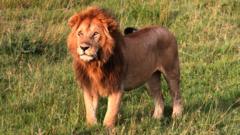The incident occurred near Nairobi National Park, where the girl was reportedly taken from a residential compound on a ranch. The Kenya Wildlife Service (KWS) confirmed the heartbreaking event, stating that another teenager had raised the alarm following the incident. KWS rangers traced the lion's tracks to the nearby Mbagathi River, where they discovered the remains of the primary school student.
The lion responsible for the attack has yet to be located. In response to the incident, KWS has set up traps and deployed search teams in the area, along with implementing additional security measures aimed at preventing further attacks. Nairobi National Park, situated only about 10 kilometers (six miles) from the city center, is home to a variety of wildlife, including lions, buffalos, giraffes, leopards, and cheetahs. Although the park is fenced on three sides to limit animal incursions into urban areas, it remains open on the southern side to facilitate animal migration.
Conflicts between lions and humans in Kenya are not unusual, particularly in relation to livestock. However, fatalities are relatively rare. In a separate incident the previous weekend, KWS reported that a 54-year-old man was killed by an elephant in Nyeri county, approximately 130 kilometers (80 miles) north of Nairobi. This man was attacked while the elephant grazed in Mere Forest and ultimately succumbed to critical injuries after being taken to a nearby hospital.
Conservation advocate Paula Kahumbu, director of WildlifeDirect, emphasized that these incidents reflect larger systemic issues. She called for KWS to enhance "risk assessments" and provide timely communication regarding wildlife movements in high-risk locations like Savannah Ranch, the site of the earlier attack. She further recommended that all lodges, camps, and residential areas adjacent to wildlife habitats be equipped with anti-predator deterrent systems—including lighting, alarms, secure fencing, and deterrent sprays—stressing that "prevention is our first and best line of defense."
The community and local wildlife authorities continue to grapple with the need for safety measures that protect both people and wildlife in this shared habitat.
The lion responsible for the attack has yet to be located. In response to the incident, KWS has set up traps and deployed search teams in the area, along with implementing additional security measures aimed at preventing further attacks. Nairobi National Park, situated only about 10 kilometers (six miles) from the city center, is home to a variety of wildlife, including lions, buffalos, giraffes, leopards, and cheetahs. Although the park is fenced on three sides to limit animal incursions into urban areas, it remains open on the southern side to facilitate animal migration.
Conflicts between lions and humans in Kenya are not unusual, particularly in relation to livestock. However, fatalities are relatively rare. In a separate incident the previous weekend, KWS reported that a 54-year-old man was killed by an elephant in Nyeri county, approximately 130 kilometers (80 miles) north of Nairobi. This man was attacked while the elephant grazed in Mere Forest and ultimately succumbed to critical injuries after being taken to a nearby hospital.
Conservation advocate Paula Kahumbu, director of WildlifeDirect, emphasized that these incidents reflect larger systemic issues. She called for KWS to enhance "risk assessments" and provide timely communication regarding wildlife movements in high-risk locations like Savannah Ranch, the site of the earlier attack. She further recommended that all lodges, camps, and residential areas adjacent to wildlife habitats be equipped with anti-predator deterrent systems—including lighting, alarms, secure fencing, and deterrent sprays—stressing that "prevention is our first and best line of defense."
The community and local wildlife authorities continue to grapple with the need for safety measures that protect both people and wildlife in this shared habitat.




















